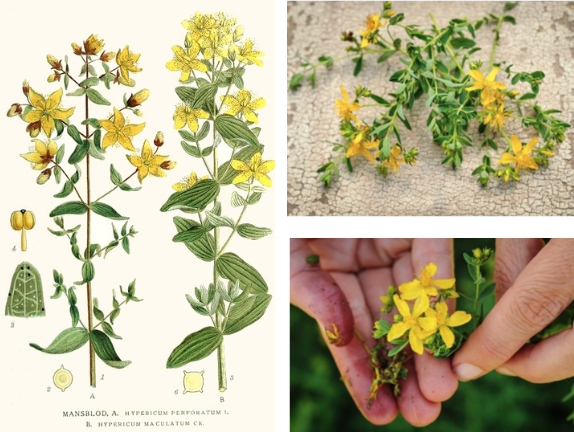Latin Name: Hypericum perforatum
Herb Class/Action: Adaptogen, Nervine, Trophorestorative
Parts Used: Flowering tops
Flavors: Bitter (hepatic), pungent, astringent, aromatic
Energetics: Cooling, drying
Traditional Benefits: Mood support, liver support, brain support, solar plexus support
Considered both an adaptogen and a trophorestorative tonic to the nervous system, St. John’s Wort has been studied for its positive therapeutic potential in terms of mood, brain, and nervous system support.
One of the earliest recorded accounts of the use of St. John’s Wort dates back to the 6th century AD when St. Columbia was said to carry a piece of this herb in his pocket due to his great regard for St. John (who just happens to represent the light, with his feast date on the Solstice!)

This connection to ‘light’ fits perfectly with its eclectic traditional usage in herbalism, where it is said to “bring light into darkness in the mind” thanks to its bright yellow that gives us clues about its unique offerings. St. John’s Wort also blooms on the solstice, bringing new life and light that energizes, nourishes and reinvigorates the nervous system.*
Traditional texts single out St. John’s Wort as a sacred herb, used in early religious practices across Europe. Russian Czar Michaele I demanded that no less than 100 pounds of this herb be delivered to his court each year, and many Europeans would hang this plant above their doorway or sleep with it under their pillow for blessings and protection. Medicinally, St. John’s Wort “appears to condense the energies of the sun” [Claudia Keel] as it brings its solar energy to the psyche in order to support a healthy mood and sense of wellbeing.
In modern times, there have been hundreds of randomized controlled studies on St. John’s Wort with many supporting its positive effect on mood, especially when the whole plant is used in order to capture its full spectrum of phytochemicals and antioxidants (including Quercetin and Lutein). Further clinical research is needed to assess long term effects.*
St. John’s wort can be found growing in sunny open areas and depleted soils (as it restores them just like it does us!), dry pastures and fields, and disturbed sites such as country roads and highways. Flowering tops should be harvested between the solstice and September when the sun is shining.
“It is as impossible to make bread without flour as it is to heal people without Saint John’s Wort” – Russian Proverb